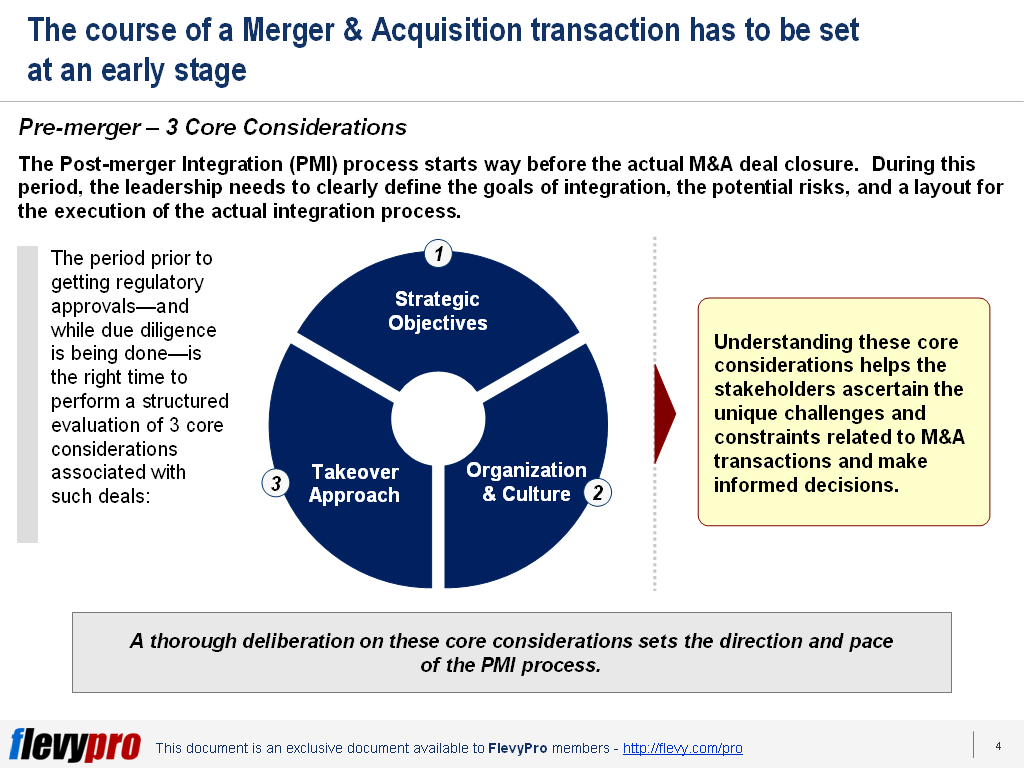
 Become a PowerPoint Guru by Dave Tracy
Become a PowerPoint Guru by Dave Tracy
Learn the methodologies, frameworks, and tricks used by Management Consultants to create executive presentations in the business world.

 Become a PowerPoint Guru by Dave Tracy
Become a PowerPoint Guru by Dave Tracy
 The impact of the global pandemic, volatile stock markets, and slowed economic outlook across the globe has hurt the performance of enterprises across the world. The scenario has forced leaders to consider undertaking Transformation of their strategy and operations significantly.
The impact of the global pandemic, volatile stock markets, and slowed economic outlook across the globe has hurt the performance of enterprises across the world. The scenario has forced leaders to consider undertaking Transformation of their strategy and operations significantly.
The strategy to buy out troubled businesses and determining to fix the issues that upset the target companies has been a focus of Buyers’ senior leadership for the past 2 decades. In the year 2017 alone, 36,000 M&A (Mergers & Acquisitions) transactions were announced globally. Acquisition of troubled businesses hoping to have a Turnaround account for around 50% of all M&A deals.
A Turnaround can be defined as the financial recovery of an economy or an organization after a period of inertia or Downturn. Several issues trigger a Downturn—issues pertaining to technological disruption, regulations, processes, organization’s financial health, management, business model, hierarchy, or competition.
The ratio of success for M&As is, however, not very healthy. Historical data of 61% of M&A deals based on a BCG’s study, carried out on 1400 M&A deals globally between 2005 and 2018, shows a high failure rate (61%), where they remained unsuccessful to show any improvement in financial performance.
The ones that do succeed offer significant revenue growth and profit margins—around 25% positive variance in TSR than unsuccessful M&As. However, buying and fixing a business under the weather isn’t an easy job. This necessitates a meticulous strategy.
In order to materialize a Turnaround, the leadership needs to thoroughly understand the root cause(s) of the Downturn, have a willingness and plan to reform or transform, and rigorously implement the strategy to rectify the situation (Transformation Execution).
Empirical Research demonstrates that the triumph of M&A Turnaround deals is attributable to 6 Critical Success Factors:
Deployment of a combination of these CSFs bring about more pronounced outcomes—in terms of positive 3-year TSR and overall Organizational Performance.
A robust M&A Turnaround Strategy—based on lessons learnt from empirical research—revolves around 4 key M&A Deal Characteristics. These M&A deal characteristics have a profound impact on the outcome of the transaction:
Knowledge of these key Deal Characteristics allow the senior leadership to ascertain the factors liable to affect the deal outcomes. Now, let’s discuss the first 2 deal characteristics in a bit detail.
The performance of the Target company during 2 years pre-deal is a key point to consider for a M&A, as it is directly proportional to the deal success rate and Total Shareholder Return. BCG’s research demonstrates that M&A transactions where the target entity had a 2-year TSR decline of lower than 10% were liable to be more successful than deals where target companies were in more distress (a decline of ~30% or more).
Senior leaders should not ignore the significance of uniformity of sectors of the target and acquiring company. Based on research, the rate of success for an acquisition transaction involving the buyer and the target operating in the same industry is 5% superior to the rate for transactions involving the companies from different sectors. The reason for this higher success rate is attributed predominantly to similar business models, customers, vendors, and processes in firms of the same sector, which make the Post-merger Integration of the buyer and target a lot easier.
Interested in learning more about the other characteristics influencing the outcome of an M&A deal? You can download an editable PowerPoint presentation on M&A Turnaround Strategy here on the Flevy documents marketplace.
You can download in-depth presentations on this and hundreds of similar business frameworks from the FlevyPro Library. FlevyPro is trusted and utilized by 1000s of management consultants and corporate executives. Here’s what some have to say:
“My FlevyPro subscription provides me with the most popular frameworks and decks in demand in today’s market. They not only augment my existing consulting and coaching offerings and delivery, but also keep me abreast of the latest trends, inspire new products and service offerings for my practice, and educate me in a fraction of the time and money of other solutions. I strongly recommend FlevyPro to any consultant serious about success.”
– Bill Branson, Founder at Strategic Business Architects
“As a niche strategic consulting firm, Flevy and FlevyPro frameworks and documents are an on-going reference to help us structure our findings and recommendations to our clients as well as improve their clarity, strength, and visual power. For us, it is an invaluable resource to increase our impact and value.”
– David Coloma, Consulting Area Manager at Cynertia Consulting
“As a small business owner, the resource material available from FlevyPro has proven to be invaluable. The ability to search for material on demand based our project events and client requirements was great for me and proved very beneficial to my clients. Importantly, being able to easily edit and tailor the material for specific purposes helped us to make presentations, knowledge sharing, and toolkit development, which formed part of the overall program collateral. While FlevyPro contains resource material that any consultancy, project or delivery firm must have, it is an essential part of a small firm or independent consultant’s toolbox.”
– Michael Duff, Managing Director at Change Strategy (UK)
 Takeovers can turnaround companies in a short period of time, but there is a significant degree of risk to be anticipated and mitigated prior to undertaking such transactions. Lack of careful deliberation of the potential risks, insufficient planning, weak execution, and lack of focus on Post-merger Integration are the major reasons why many Merger & Acquisition deals fail to achieve their desired goals.
Takeovers can turnaround companies in a short period of time, but there is a significant degree of risk to be anticipated and mitigated prior to undertaking such transactions. Lack of careful deliberation of the potential risks, insufficient planning, weak execution, and lack of focus on Post-merger Integration are the major reasons why many Merger & Acquisition deals fail to achieve their desired goals.
The course of an M&A transaction has to be set at an early stage, way before the actual deal closure. The period prior to the deal approval by the regulatory authorities and while due diligence is being done is most critical, and should be utilized by the leadership to clearly define the goals of integration, the potential risks, and a layout for the execution of the actual integration process. It is the right time to perform a structured evaluation of 3 core pre-merger considerations associated with such deals, i.e.:

Understanding these PMI Pre-merger considerations helps the stakeholders ascertain the unique challenges and constraints related to M&A transactions and make informed decisions. These considerations assist in developing a systematic approach to undertaking a Post-merger Integration (PMI) — which is devoid of any “gut decisions,” and ensures realization of synergies and value. These considerations set the direction and pace of the post-merger integration process.
Now, let’s discuss the 3 core considerations in detail.
Organizations undertake Mergers and Acquisitions as a way to accelerate their growth rather than growing organically. The foremost core consideration associated with an M&A transaction is the strategic objectives that the organizational leadership wants to achieve out of it.
M&A deals take place to fulfill one or more of these 5 strategic objectives:
The PMI approach needs to be tailored in accordance with the desired strategic objectives of the deal.
The senior management should be mindful of the significance of organizational and cultural differences in the two organizations that often become barriers to M&A deals. Small companies, typically, have an entrepreneurial outlook and culture where there aren’t any formal structure and the owner controls (and relays) all the information and decision making. Whereas, large corporations typically have formal structures and well-defined procedures.
A takeover of a small firm by a large entity is bound to stir criticism and disagreement. M&A process often faces long delays between the offer, deal signing, and closing — due to antitrust reviews or management’s indecisiveness — triggering suspicion among people. This should be mitigated during the PMI process by orienting the people of the small firm with the new culture and giving them time to transition effectively.
For M&A deals to be effective, leadership needs to carefully evaluate the behavioral elements of the organizational culture and contemplate the overriding principles guiding a company.
Integrating the operations of two companies proves to be a much more difficult task in practice than it seems theoretically. Organizations have the option of selecting the takeover approach most suitable for them from the following 4 methodologies — based on their organizational structures, people, management, processes, and culture:
Interesting in learning more about the takeover approach and the pre-merger considerations in detail? You can download an editable PowerPoint on Post-merger Integration: Pre-merger Considerations here on the Flevy documents marketplace.
You can download this and hundreds of other consulting frameworks and consulting training guides from the FlevyPro library.
 Stiff market competition, expansion into new territories, product portfolio extension, and gaining new capabilities are the prime reasons why more and more organizations are seriously looking into the prospects of—and carrying out—Mergers and Acquisitions. However, only a few M&As achieve their desired revenue objectives.
Stiff market competition, expansion into new territories, product portfolio extension, and gaining new capabilities are the prime reasons why more and more organizations are seriously looking into the prospects of—and carrying out—Mergers and Acquisitions. However, only a few M&As achieve their desired revenue objectives.
Revenue Synergies are a decisive factor in closing such deals. However, identifying precisely where these Revenue Synergies lie and then capturing them isn’t as easy as it sounds.
A McKinsey study comprising of 200 M&A executives from 10 different sectors revealed that all the respective organizations of the respondents remained short of achieving their Revenue Synergy targets (~23% short of the target on average). Securing Revenue Synergies is a long-term game. The companies that succeed in securing Revenue Synergies achieve the target in or around 5 years.
Leaders aspiring to achieve Revenue Synergies should first clarify the objectives from and the schedule of the revenue synergies, lay out the organizational priorities and go-to-market strategies, remove obstacles from realizing value, and gain across the board readiness and commitment for the initiative. Organizations that are most successful in securing revenue synergies pay close attention to these 7 guiding principles during the Post-merger Integration process:
These 7 guiding principles to capturing Revenue Synergies are critical for effective integration of two firms after a merger and unlocking potential benefits from the deal. Let’s discuss the first 3 principles in detail now.
The inability of the leadership of the acquiring company to spot major sources of revenue that integration brings in results in losing significant pools of opportunity and failure of M&As. Realizing Revenue Synergies demands a thorough methodology to ascertain and qualify revenue prospects along markets and channels, Go-to-Market Strategies, and developing commercial capabilities. This entails:
Organizations that accomplish their Revenue Synergy objectives guarantee that their top management and employees commit themselves fully to the initiative from the onset. They identify potential value pockets from the integration, examine the assumptions about securing value, and get them endorsed by the senior management and front-line staff. The potential Revenue Strategies are regularly evaluated by inter-departmental experts.
Accurate estimation of Revenue Synergies demands top-level estimates—assumptions on market share gain, revenue enhancement, or improved penetration—alongside comprehensive bottom-up customer insights, and evaluation of customer relationships. Other important elements to consider include analyzing the offerings being offered to customers, discerning other potential products and services required by the customers, and assessing the ability of the sales team and brands in terms of the potential they offer to the clients.
Interested in learning more about the other guiding principles of securing PMI revenue synergies? You can download an editable PowerPoint on Post-merger Integration (PMI): Securing Revenue Synergies here on the Flevy documents marketplace.
You can download this and hundreds of other consulting frameworks and consulting training guides from the FlevyPro library.
Error: Twitter did not respond. Please wait a few minutes and refresh this page.